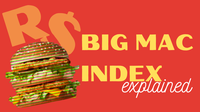
There exists a concept in mainstream economics known as Burgernomics which combines the words ‘burger’ and ‘economics’. You might well ask what links these two things. The answer is the Big Mac Index (BMI), a layperson-friendly tool that has become something of a global standard for explaining or indeed observing exchange-rate theory.
What is the Big Mac Index?
Basically, in an equal market (a market where every relevant factor, such as resources, labour, education and so on are equal), the price of an ordinary Big Mac burger available at your regular McDonald’s fast food restaurant would be the same all around the world. But the global market is not equal, given the many variables such as the cost of labour and the availability of resources. Thus, the price of a Big Mac varies from country to country. Now, the Big Mac Index is used as a measure of the purchasing power parity of a country’s currency. Before I lose you, let’s answer this question first:
What is Purchasing Power Parity (PPP)?
In essence, purchasing power parity is the measure of how strong or weak a currency is – that currency’s ability to buy certain goods as compared to others. It is determined by comparing the cost of the same basket of goods in different countries (currencies). This is useful for determining whether a country is as well-off as its Gross Domestic Product or exchange rate would suggest, therefore providing the answer to the question: “What is true power of this currency?”
This is where the Big Mac comes in…
The Big Mac is sold worldwide (in over 100 countries), using the same ingredients. So, it is more than apt that it qualifies as a measure of a country’s purchasing power parity. By comparing how much a Big Mac costs in one country (using that country’s currency) to another country (using that other country’s currency), we can determine the respective purchasing power parity of each currency.
As recently as February 2022, a Big Mac burger cost R39.90 in South Africa, whereas in the USA, it cost $5.81. When converted into Dollars, R39.90 is equivalent to $2.22. This means that a Big Mac in South Africa costs nearly half of what it costs in the United States. Thus, South Africa has a higher purchasing power parity than the USA – the price of one Big Mac there gets you two over here.
This would imply that the Rand has a higher purchasing power than the Dollar – you can get the same basket of goods (the Big Mac) for less money here in South Africa than in the USA. The implication is that the Rand counts for more, so you pay less.
How is the Big Mac Index useful to you, the average South African?
Well, it’s a great and easy way to track how the Rand is performing and it is also useful for determining the value of our currency. For instance, you can use the index to compare our purchasing power parity against other currencies. You can also use the index to track our inflation rate – if you compare the price changes of the Big Mac in our country over a given period, you can get an idea of the relative price change. The index can also be used to indicate whether we are experiencing higher or lower rates of inflation compared with other countries.
Furthermore, by using the Big Mac Index, you can determine whether our currency (or any other currency) is under/overvalued in comparison to another currency. Again, before I lose you… All we are doing here is comparing the exchange rate implied by the Big Mac Index against the actual (real-life currency to currency) exchange rate. Thus, if the Big Mac exchange rate is less than the actual exchange rate, then that currency is undervalued by the currency you are comparing it against, and vice-versa.
Consider this illustration:
Using the example above, we have already determined that a Big Mac in South Africa is R39,90 and, in the US, it is $5.81.
This means that the Big Mac exchange rate is 0.15 (because 5.81/39.90 = 0.15).
The actual Dollar/Rand exchange rate is currently 0.56 (because $1 = R17.93. Therefore, 1/17.93 = 0.56).
Therefore, 0.15 < 0.56, means that the Rand is undervalued by the Dollar.
According to these calculations, the Rand is 73,2% undervalued by the US Dollar. This is because (0.15-0.56)/0.56 = - 0,732.
It is important to note that the Big Mac Index is not an accurate method, as it ignores many other crucial facts that affect exchange-rate theory. For instance, in the example I used above, for the price of one American Big Mac burger, you can get two in South Africa and still be left with change, meaning that the rand has a higher PPP than the dollar. But could you use that as an accurate measure of the wealth of our currency? No. Things like labour costs (which are also affected by law – laws differ), quality of resources used, and production processes among other things, affect the price of items (ie: the Big Mac). We might have a cheaper Big Mac here in SA, but it could very well be a much less inferior one in quality (we might be using the same ingredients, but of lesser quality). This would mean that our PPP is only higher because we are cheapskates! That’s only one example. There are many others. Also, as global as McDonald’s is, the fast-food chain is not active in every country, nor is the Big Mac sold wherever there is a McDonald’s. Thus, you cannot use the BMI everywhere.
The Big Mac Index is therefore useful to the extent of being merely a more understandable way of explaining exchange-rate theory. It does not require an extensive knowledge of economics. It is perfect for you and me.
